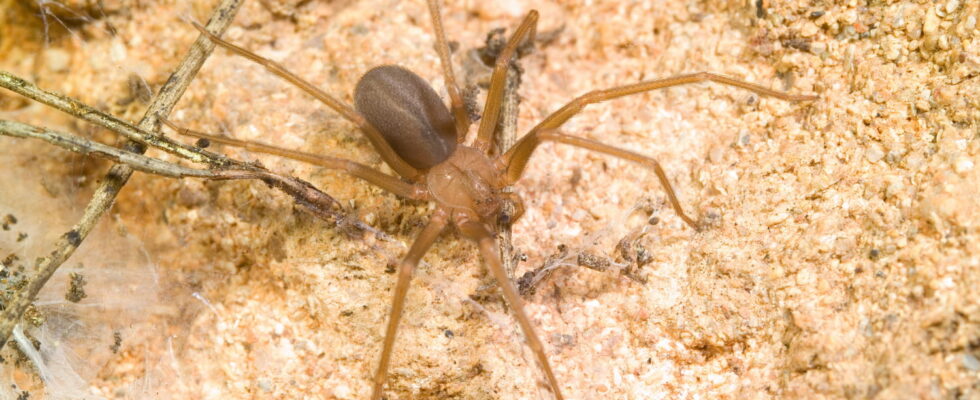Present in the south of France, the violinist spider is scary. However, “this species is shy, fearful and harmless” according to an expert we interviewed.
The violin spider or “violin spider” (Loxosceles rufescens) is present in Europe (including France) around the Mediterranean. The main danger of a violin spider bite is the skin necrosis “but he is very, very weak” Florian Alonso, an independent spiderologist, immediately points out. On July 12, 2024, an Italian gendarme died in Palermo (Sicily) 5 days after being bitten by a violin spider, according to the Italian newspaper La Rai. “Given how the victim’s health deteriorated, the cause of death, and the contextual information, we can be fairly certain that his death was not caused by a bite from a fiddler Loxosceles rufescens” reacts our interlocutor.
How to recognize the violin spider?
The violin spider or “violin spider” is a spider of the genus loxosceles called “Loxosceles rufescens”. It is called this because of its small violin-shaped stain on its cephalothorax (the part that carries the legs). It has a reddish-sand color. The body of the violinist spider measures 6 to 10 mm. It has 6 eyes (compared to 8 for the majority of spiders) divided into three groups and in a U shape. Its long and thin legs, placed on the side, are the same color as its body. It should not be confused with the brown recluse (L. reclusa), an American cousin.
Photo of a violin spider
What are the dangers if bitten?
“Bites from Loxosceles rufescens are very rare. Loxosceles rufescens is a small, extremely secretive and extremely fearful spider that only bites when certain fairly specific conditions are met, namely that the spider’s body is being crushed and there is no possible escape. The spider’s defensive bite reflex is a spider’s last resort to defend itself.” Florian Alonso explains to us. The violinist spider has venom that she does not release with each bite. Her bite can cause skin necrosis but it is “rare” according to the specialist and none have been fatal in France. In case of envenomation, we speak of loxoscelism. “Envenomations resulting from a bite of Loxosceles rufescens are rare. And in very rare cases, envenomation can indeed result in tissue necrosis but limited in size and depth and which will not require, or will not pose a risk of amputation” the spiderologist is keen to point out.
How many cases of violin spider bites in France?
The violin spider likes warm, dry and dark places (cupboards, garages, etc.). In France, it is mainly present in Mediterranean regions, under stones and bark. Its activity is mainly nocturnal. Cases of violin spider bites have been reported in France but “Any alleged bite outside the Mediterranean area must be viewed with the highest level of skepticism” according to Florian Alonso. The cases reported below in the fall of 2015, in 2020 in Nancy and 2022 have not “with near certainty, nothing to do with a violin spider bite”:
► In July 2022, A resident of Treffort (near Grenoble) was reportedly bitten by a violin spider brought back from a trip to Guyana. She was bedridden in the infectious diseases department of the Bourg-en-Bresse Hospital Center.
► In June 2020a 60-year-old man living near Nancy was reportedly bitten on the hand while he was sleeping. The bite became infected and the victim had to undergo four operations and a graft to repair his hand, theIs RepublicanTwo other cases of “recluse” bites were recorded that summer in the Grand Est department (Neuves-Maisons and Lunéville), according to the victim’s doctors.
► In May 2019, A man living in Montpellier reported being bitten by a violin spider, but without complications.
► In October 2015a 78-year-old man living in Seine-et-Marne is said to have been the victim of the fiddler spider, as well as another from Charente-Maritime. In August 2016, a Belgian tourist who came on holiday to Vaucluse was bitten by a fiddler spider and apparently escaped amputation.
It measures 6 to 9 mm.
► During the summer of 2015, 9 cases of fiddler spider bites resulting in significant necrosis have been reported in the PACA and Occitanie regions. Five patients had to be operated on due to tissue necrosis. “Only 2 have actually been attributed to a fiddler spider bite. Loxosceles rufescens” emphasizes our interlocutor.
What are the differences between the violinist spider and the brown recluse?
The fiddler spider is often mistakenly confused with the “brown recluse” which also belongs to the genus loxosceles. The first is the Loxosceles rufescens when the second is the Loxosceles reclusaa neighbor who looks a lot like her and who is present in the United States (not in France!). These two spiders are venomous.. But recluse spider bites have already been linked to cases mortals Across the Channel, which is not not the case of the violin spider.
How big is the violin spider?
A violin spider measures 6 to 10 mm.
What are the symptoms of a violin spider bite?
The violinist spider bite is little painful and causes variable reactions from one person to another. Ranging frombenign inflammation to a slight ulceration without complications, or more seriously to a red and painful closet around the bite with an extension of red, white, blue color. Fever, significant fatigue, joint pain, nausea and dizziness may be observed in case of envenomation.
What to do if bitten by a violin spider?
Disinfect the woundapply ice to soothe the “fire” of the inflammation and take painkillers if necessary. If the symptoms worsen, consult a doctor immediately to monitor the progress or even call the emergency services (15) in case of signs of severity (fever, convulsion, beginning of necrosis, etc.). Taking antibiotics is controversial, as are antihistamines and antivenoms.
